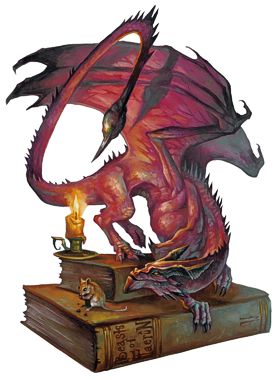

Monstrous Manual

| Climate/Terrain: | Temperate or subtropical forests and caves |
|---|---|
| Frequency: | Very rare |
| Organization: | Solitary |
| Activity Cycle: | Day |
| Diet: | Omnivore |
| Intelligence: | Average (8-10) |
| Treasure: | Q (×10) |
| Alignment: | Neutral (good) |
| No. Appearing: | 1 (50% chance of 1-8 in nests) |
| Armor Class: | 2 |
| Movement: | 6, Fl 24 (B) |
| Hit Dice: | 2 |
| THAC0: | 19 |
| No. of Attacks: | 1 |
| Damage/Attack: | 1-3+special |
| Special Attacks: | Poison sting |
| Special Defenses: | Chameleon power |
| Magic Resistance: | 35% |
| Size: | T (1˝’ long) |
| Morale: | Champion (15) |
| XP Value: | 420 |
Pseudodragons are a species of small flying lizard that inhabits heavily forested wilderness areas. These playful, benign creatures have magical powers that they can share with others, so they are often sought as companions.
Pseudodragons resemble miniature red dragons. They have fine scales and sharp horns and teeth. A pseudodragon’s coloration is red-brown as opposed to the deep red of red dragons. Its tail is about 2 feet long (longer than the pseudodragon itself), barbed, and very flexible.
Pseudodragons communicate via a limited form of telepathy. If one elects to take a human companion, it can transmit what it sees and hears at a distance of up to 240 yards. Pseudodragons can vocalize animal noises such as a rasping purr (pleasure), a hiss (unpleasant surprise), a chirp (desire), or a growl (anger).
Combat: The pseudodragon can deliver a vicious bite with its small, dragonlike jaws, but its major weapon is its sting-equipped tail. The creature can move it with flashing speed and strikes at +4 on attack rolls. Any creature struck must save vs. poison or go into a state of catalepsy that lasts 1-6 days. The victim appears quite dead, but at the end of that time the character will either wake up unharmed (75% chance) or die (25% chance).
Pseudodragons have a chameleonlike power that allows them to alter their coloration to blend with their surroundings. They can blend into any typical forest background with an 80% chance of being undetected by creatures which cannot see invisible objects. Pseudodragons have infravision with a 60 foot range and can see invisible objects.
A pseudodragon is highly magic resistant and can transmit this magic resistance to its human companion via physical contact (a pseudodragon likes to be perched on the top of one’s head or curled around the shoulders and upper back).
Habitat/Society: These forest-dwelling creatures place their lairs in the hollows of great trees or in large caves.
A pseudodragon will very rarely take a human or demihuman as its companion. Some view these pseudodragons as the human’s pet; the pseudodragon will be sure to correct this misunderstanding. There are two ways to become a pseudodragon’s companion; one is to use magic to summon it (a find familiar spell). Another way is to find the pseudodragon on an adventure and pursuade it to become a companion.
The pseudodragon that searches for companionship will stalk a candidate silently for days, reading his thoughts via telepathy, judging his deeds to be good or evil. If the candidate is found to be good, the pseudodragon will present itself to the human as a traveling companion and observe the human’s reaction. If the human seems overjoyed and promises to take very good care of it, the pseudodragon will accept. If not, it will fly away.
The personality of a pseudodragon has been described by some as catlike. A pseudodragon is willing to serve, provided that it is well-fed, groomed, and receives lots of attention. At times a pseudodragon seems arrogant, demanding, and less than willing to help. In order to gain its full cooperation, the companion must pamper the pseudodragon and make it feel as though it were the most important thing in his life. If the pseudodragon is mistreated or insulted it will leave, or worse, play pranks when least expected. Pseudodragons particularly dislike cruelty and will not serve cruel masters.
Ecology: Pseudodragons are omnivorous but prefer to eat meat. Their diet consists chiefly of rodents and small birds with occasional leaves, fruits, and berries. In the wild, pseudodragons live solitary lives, protecting small personal hoards in their nests. They gather to mate once per year, in early spring, when gatherings of dozens of pseudodragons are not uncommon. After mating, males and females separate; females lay speckled brown eggs in clutches of four to six which hatch in mid-summer; females raise the young by themselves. Pseudodragons hibernate in winter; the young leave the nest in spring to mate.
Pseudodragons have a lifespan of 10-15 years. Like dragons, they are attracted to bright shiny objects.
Pseudodragon eggs can be resold for up to 10,000 gold pieces while a hatchling is worth as much as 20,000 gold pieces.
